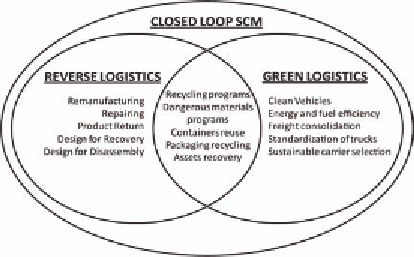Environmental Engineering Reference
In-Depth Information
Figure 1. Green Logistics vs. Reverse Logistics
vs. Closed-loop Supply Chain Management
design, on-site recycling, and optimal dis-
position of products.
•
Value added services, e.g.:
pallet and con-
tainer pooling, tracking and tracing, and
using green packaging technologies.
In addition to “green logistics,” two other
concepts exist also address environmental is-
sues in the context of the management of flows
of material and information within and between
organizations: reverse logistics and closed-loop
supply chain management.
•
Reverse logistics:
While traditional lo-
gistics seeks to optimize forward distribu-
tion within a value chain, environmental
considerations have created new business
markets for reverse logistics, encompass-
ing “(logistics) activities all the way from
used products no longer required by the
user to products again usable in a mar-
ket (Fleischmann et al. 1997)”. Given
this definition, reverse logistics not only
covers transportation, warehousing, and
value added services in the context of
re-
distribution
of end-of life products and
residuals but also their collection, product
inspection, dismantling and separation,
reprocessing of secondary materials and
products, and distribution into productive
processes (Voigt & Thiell 2004, Kumar &
Malegeant 2006).
•
Closed-loop supply chain management
(CLSCM):
The widest scope of environ-
mental concepts affecting logistics systems
is CLSCM. CLSCM requires a re-defini-
tion of supply chain tasks and a redesign
of the chain structure, since closed-loop
supply chains add complexity to their
management (Rogers & Tibben-Lembke
1998, Beaman 1999, Van Wassenhove &
Geyer 2002) by adding actors (e.g. recy-
clers, landfill operators) and activities (e.g.
example of this closed-loop supply chain
is common in Europe. The enforcement
of environmental legislation by various
governments assigns to manufactures the
social responsibility for closed-loop flows,
including used products, residuals and
wastes (Robeson et al. 1992, Fleischmann
et al. 2000, Voigt & Thiell 2004). This
more comprehensive management frame-
work addresses issues of green product
design, used product recycling, waste dis-
posal, and manufacturing-induced pollu-
tion alleviation.
Figure 1 summarizes the activities of closed-
loop supply chain management, green and reverse
logistics.
Economic and Social Value of Green
Logistics
The drivers of the green logistics mentioned above
highlight the general necessity of integrating
environmentally friendly practices into logistics
systems. Such practices have yet to gain general
acceptance worldwide, however. Possible
general
factors
restraining companies from creating the
green logistics systems mentioned in the literature
are cost, lack of awareness, coordination and
communication, as well as resistance (Carter

